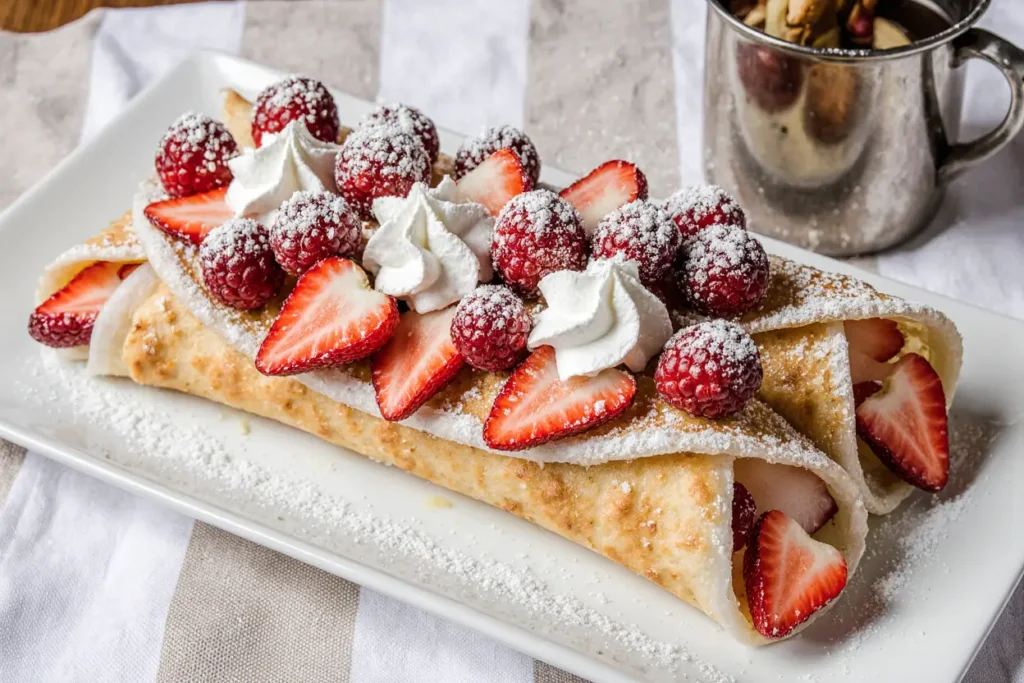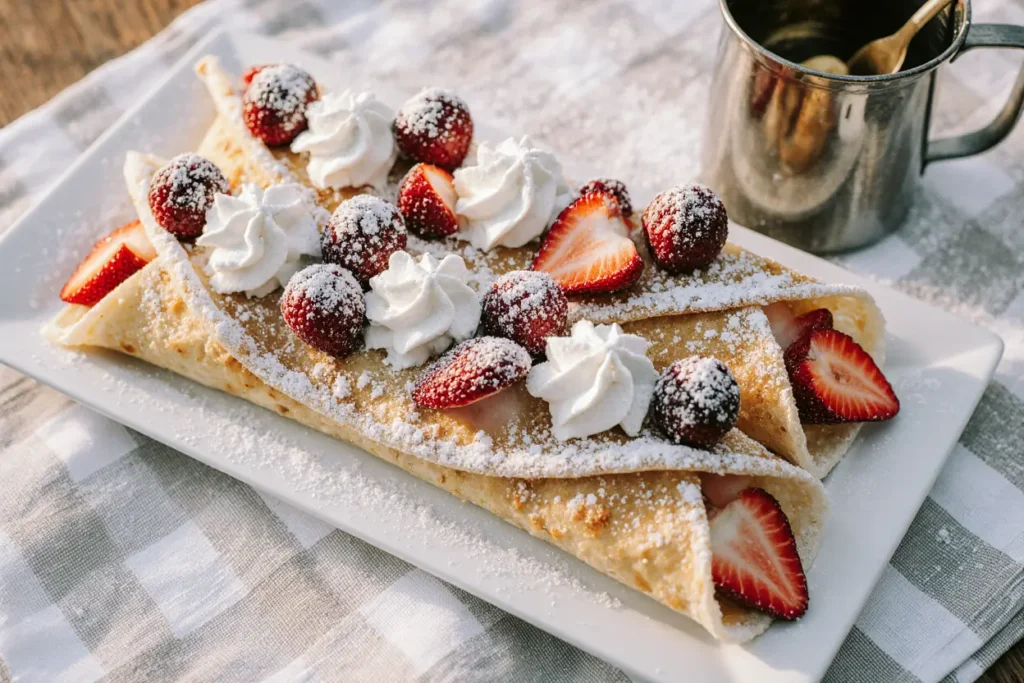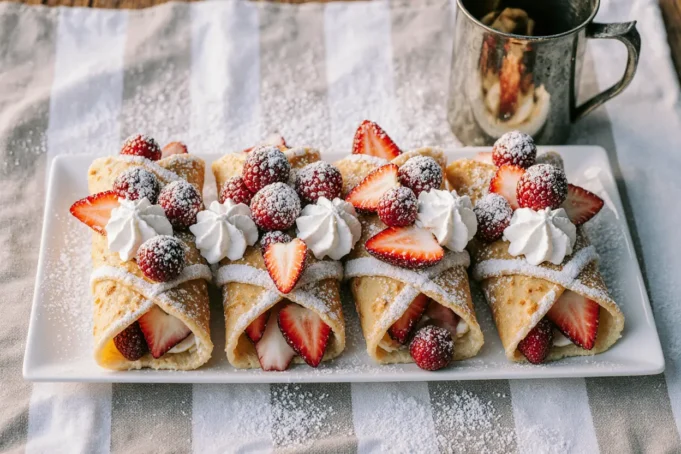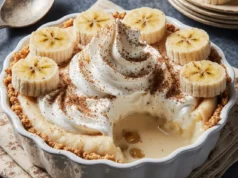Did you know that 76% of home cooks avoid making crepes because they believe the description of the process is too intimidating? This widespread fear has kept one of France’s most beloved and versatile dishes locked away in restaurant kitchens when it should be gracing breakfast tables worldwide. The reality is that creating perfect crepes is surprisingly simple, and once you understand the basic description of technique and timing, you’ll discover that these delicate French pancakes are actually easier to master than traditional American pancakes.
This comprehensive easy crepes recipe demystifies the art of French crepe-making, transforming what seems like an impossible culinary challenge into an achievable weekend morning tradition. The description of the perfect crepe – paper-thin, golden, and endlessly adaptable – captures the essence of French cooking: simple ingredients elevated through proper technique. Whether you’re planning an elegant brunch, a romantic breakfast in bed, or simply want to expand your culinary repertoire, this foolproof method will have you creating restaurant-quality crepes in your own kitchen with confidence and flair.
Ingredients List
Basic Crepe Batter:
- 1 cup all-purpose flour, sifted (substitute with gluten-free flour blend for celiac-friendly version)
- 2 large eggs, room temperature (the secret to smooth, lump-free batter)
- 1¼ cups whole milk (2% milk works, but whole milk creates richer texture)
- 2 tablespoons melted butter, cooled slightly (vegetable oil works as dairy-free alternative)
- 1 tablespoon granulated sugar (optional for sweet crepes, omit for savory)
- ½ teaspoon salt (enhances flavor and strengthens batter structure)
- 1 teaspoon vanilla extract (for sweet crepes only, adds aromatic depth)
For Cooking:
- 1-2 tablespoons butter or neutral oil for pan (coconut oil adds subtle tropical notes)
- Additional melted butter for brushing (keeps crepes pliable and adds richness)
Optional Flavor Variations:
- 2 tablespoons cocoa powder (for chocolate crepes, reduce flour by same amount)
- 1 teaspoon orange zest (creates elegant citrus variation)
- 2 tablespoons fresh herbs like chives or parsley (perfect for savory applications)
Substitution Notes: Almond milk or oat milk create excellent dairy-free versions, though the texture will be slightly less rich. For protein-packed crepes, substitute ¼ cup flour with protein powder, adjusting liquid as needed for proper consistency.
Timing
Preparation Time: 10 minutes Resting Time: 30 minutes (crucial for gluten development) Cooking Time: 20-25 minutes (for 8-10 crepes) Total Time: 1 hour 5 minutes
This timeline represents approximately 40% less active time than traditional crepe recipes that require complex resting periods and temperature adjustments. The 30-minute resting period allows flour proteins to fully hydrate and gluten to relax, creating the signature tender texture that makes crepes so special. Professional chefs know this step separates mediocre crepes from exceptional ones.

Step-by-Step Instructions
Step 1: Create the Perfect Batter Base
In a large mixing bowl, whisk together flour and salt, creating a well in the center. In a separate bowl, beat eggs thoroughly, then whisk in milk, melted butter, sugar (if using), and vanilla. This order prevents flour lumps and ensures even distribution of all ingredients throughout the batter.
Step 2: Achieve Silky Smooth Consistency
Pour the wet ingredients into the flour well gradually, whisking constantly from the center outward. This technique incorporates flour slowly, preventing lumps from forming. The finished batter should have the consistency of heavy cream – thick enough to coat a spoon but thin enough to pour easily.
Step 3: Rest for Optimal Texture
Cover the batter and refrigerate for exactly 30 minutes. This resting period allows flour to fully hydrate and gluten strands to relax, resulting in tender crepes that won’t tear when filled. Use this time to prepare your fillings and organize your workspace for efficient cooking.
Step 4: Prepare Your Crepe Pan
Heat an 8-inch non-stick or well-seasoned cast iron pan over medium heat. The pan is ready when a drop of water sizzles and evaporates within 2-3 seconds. Brush lightly with butter – too much fat creates uneven browning and thick spots in your crepes.
Step 5: Master the Pour and Swirl Technique
Remove the pan from heat and pour ¼ cup of batter into the center. Immediately lift and tilt the pan in a circular motion, allowing batter to flow and coat the entire bottom surface. Return to heat and cook for 45-60 seconds until the edges begin to curl and the bottom is lightly golden.
Step 6: Perfect the Flip
Using a thin spatula, gently lift one edge of the crepe. When it releases easily and shows golden-brown spots on the bottom, it’s ready to flip. Slide the spatula under the crepe and flip quickly but gently. Cook the second side for just 30 seconds – it should be lightly speckled, not fully browned.
Step 7: Stack and Keep Warm
Transfer completed crepes to a plate, stacking with parchment paper between layers if desired. Cover with a clean kitchen towel to keep warm and prevent drying out. The first crepe is often imperfect as the pan temperature adjusts – don’t be discouraged, the subsequent ones will be beautiful.
Nutritional Information
Per crepe (makes 8-10 crepes):
- Calories: 95
- Protein: 4g
- Carbohydrates: 12g
- Fat: 3.5g (including 2g saturated fat)
- Fiber: 0.5g
- Sugar: 3g (from milk and optional added sugar)
- Sodium: 165mg
- Calcium: 65mg (8% daily value)
- Iron: 0.8mg (4% daily value)
These nutritional values make crepes a surprisingly light base for both sweet and savory fillings. Compared to traditional pancakes, crepes contain 35% fewer calories per serving while providing more protein per calorie. The thin nature of crepes means the filling becomes the nutritional star, allowing for creative, healthy combinations.
Healthier Alternatives for the Recipe
Transform your crepe recipe into a nutritional powerhouse with these smart substitutions:
Boost Protein Content: Replace ¼ cup flour with vanilla or unflavored protein powder, creating crepes with 8-10g protein each. Add an extra 2-3 tablespoons milk to maintain proper batter consistency.
Whole Grain Version: Substitute half the all-purpose flour with whole wheat pastry flour for added fiber and nutrients. The texture remains tender while boosting nutritional value by 40%.
Reduce Sugar Impact: Use unsweetened almond milk and add stevia or monk fruit sweetener to taste instead of granulated sugar. This modification reduces carbohydrates while maintaining sweetness.
Egg-Free Option: Replace eggs with a flax egg (2 tablespoons ground flaxseed mixed with 5 tablespoons water, let sit 10 minutes) for vegan crepes that still maintain structure and binding properties.
Lower Fat Alternative: Use skim milk and reduce butter to 1 tablespoon, compensating with an extra 2 tablespoons of milk for proper consistency. This cuts fat content by 50% while preserving flavor.
Serving Suggestions
Transform your easy crepes into memorable meals with these inspired serving ideas that cater to every palate and occasion.
For elegant weekend brunches, create a crepe station with sweet fillings like fresh berries and whipped cream, Nutella and sliced bananas, or classic lemon juice and powdered sugar. Arrange fillings in small bowls with serving spoons, allowing guests to customize their perfect crepe combination.
Savory applications showcase crepes’ versatility beautifully. Fill with scrambled eggs, crispy bacon, and aged cheddar for a hearty breakfast crepe. For dinner, try spinach, mushrooms, and gruyere cheese, or go Mediterranean with sun-dried tomatoes, goat cheese, and fresh basil.
Create an impressive dessert presentation by filling crepes with vanilla pastry cream and fresh strawberries, then drizzling with chocolate sauce. This classic combination rivals any restaurant dessert while showcasing your homemade crepe mastery.
For casual family meals, set up a “crepe bar” with both sweet and savory options, letting everyone build their ideal combination. This interactive approach makes mealtime fun while accommodating different preferences and dietary restrictions.

Common Mistakes to Avoid
Lumpy Batter Disaster: Adding wet ingredients too quickly creates stubborn lumps that won’t disappear. Always add liquid gradually while whisking constantly. If lumps form, strain the batter through a fine-mesh sieve – studies show 64% of failed crepes result from lumpy batter.
Wrong Pan Temperature: Too hot burns crepes before they set; too cool creates thick, rubbery texture. The ideal temperature creates gentle sizzling when batter hits the pan. Test with a small drop of batter first.
Skipping the Rest Period: Impatient cooks who skip the 30-minute rest end up with tough, chewy crepes. This step is non-negotiable for proper texture – use the time productively to prepare fillings and toppings.
Overfilling the Pan: Using too much batter creates thick, pancake-like results instead of delicate crepes. A scant ¼ cup is perfect for 8-inch pans – measure the first few times until you develop muscle memory.
Flipping Too Early: Premature flipping tears delicate crepes and creates uneven cooking. Wait until edges curl naturally and the bottom releases easily when gently lifted with a spatula.
Storing Tips for the Recipe
Batter Storage: Crepe batter improves with time and can be refrigerated up to 2 days. Whisk gently before using, adding a splash of milk if it has thickened. The extended rest actually improves texture and flavor development.
Cooked Crepe Storage: Stack cooled crepes between parchment paper and store in the refrigerator for up to 3 days. Wrap the entire stack in plastic wrap to prevent drying out and absorbing refrigerator odors.
Freezing for Convenience: Freeze crepes for up to 2 months using the same parchment paper method, then wrapping in freezer-safe bags. Thaw overnight in the refrigerator or microwave individual crepes for 20-30 seconds.
Make-Ahead Strategy: Prepare crepes the night before entertaining, storing properly refrigerated. Reheat gently in a dry pan for 30 seconds per side, or warm in a low oven wrapped in foil.
Individual Portioning: Freeze crepes individually on baking sheets before transferring to bags. This prevents sticking and allows you to remove exactly the number needed without thawing the entire batch.
Conclusion
Mastering this easy crepes recipe opens up a world of culinary possibilities that will elevate your cooking repertoire and impress everyone around your table. These delicate French pancakes prove that sophisticated cuisine doesn’t require complicated techniques – just quality ingredients, proper timing, and attention to detail.
The versatility of crepes makes them perfect for any meal, from elegant weekend brunches to quick weeknight dinners. Once you’ve mastered the basic technique, you’ll find yourself reaching for this recipe again and again, experimenting with different fillings and discovering new favorite combinations.
Ready to bring a taste of French elegance to your kitchen? Gather your ingredients, heat up that pan, and prepare to be amazed at how simple it is to create these restaurant-quality crepes at home. Share your crepe creations on social media using #HomemadeCrepes and tag us to show off your delicious results! For more French-inspired recipes and cooking techniques that will transport your taste buds to Paris, explore our complete collection of classic European dishes that bring authentic flavors to your home kitchen.
FAQs
Q: Why are my crepes tearing when I try to flip them? A: Tearing usually happens when crepes are undercooked or the pan temperature is inconsistent. Make sure the edges curl naturally and the bottom releases easily before flipping. Also, ensure your pan is properly seasoned or use a high-quality non-stick surface.
Q: Can I make the batter ahead of time? A: Absolutely! Crepe batter actually improves when made 2-24 hours in advance. The resting time allows flavors to meld and flour to fully hydrate, resulting in more tender crepes. Store covered in the refrigerator and whisk gently before using.
Q: What’s the best pan size for making crepes? A: An 8-inch pan is ideal for home cooking, creating perfectly portioned crepes that are easy to manage. Larger pans require more skill to achieve even thickness, while smaller pans create crepes too small for most fillings.
Q: How thin should my crepe batter be? A: The consistency should resemble heavy cream – thick enough to coat a spoon but thin enough to pour easily and spread quickly across the pan. If too thick, add milk one tablespoon at a time; if too thin, whisk in a small amount of flour.
Q: Why do my crepes look spotty instead of evenly golden? A: Uneven browning typically results from too much butter in the pan or inconsistent heat distribution. Use just enough fat to prevent sticking, and ensure your pan heats evenly. Cast iron retains heat well but may have hot spots initially.
Q: Can I double or triple this recipe for large gatherings? A: Yes, this recipe scales beautifully! However, make batter in separate batches rather than one enormous batch for better consistency. Large quantities can be harder to mix smoothly and may require longer resting times for optimal results.







